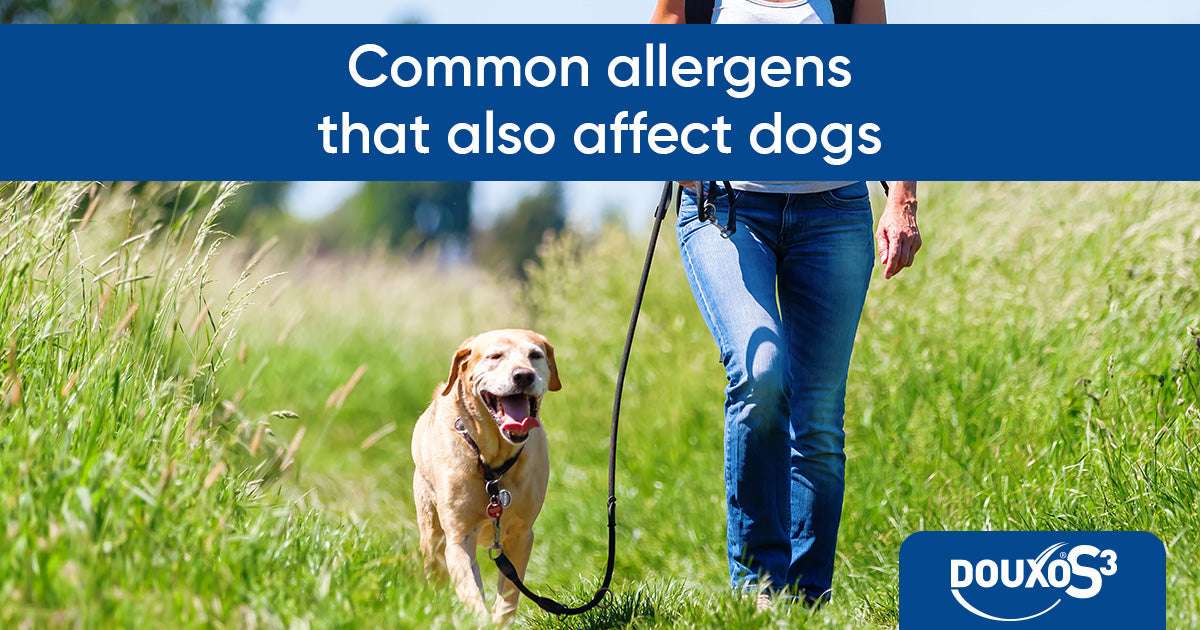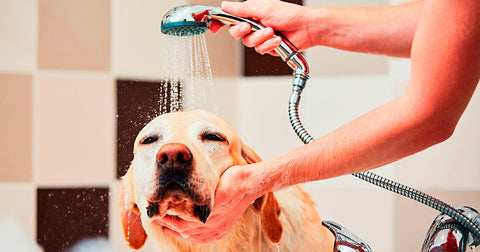
Common allergens that also affect dogs: pollens, weeds and mites
With hay-fever season getting into full swing, we’re sure a lot of readers will be checking the pollen counts on the weather forecast anxiously. But did you know that dogs are also prone to allergic responses to pollens and other common triggers? Allergies can be highly uncomfortable for our dogs, with itchy, sore skin a common symptom. If you have a dog with allergies, the most straightforward recommendation is to reduce exposure to whatever they’re allergic to as much as possible, to try and prevent these unpleasant reactions. However, in some common allergies for dogs, such as with dust mites or pollens, this is practically very difficult!
What are allergies in dogs?
An allergy happens when your dog’s immune system makes a mistake and fails to recognise something harmless, such as some pollen, and instead flags it as a threat. Your dog’s immune system then launches a response, leading to inflammation. This can cause symptoms varying from mild irritation to intense reactions.
Allergens (the things that your dog is allergic to) can be eaten, inhaled or touched. In dogs, the main way that allergens get into the body is via contact to the skin. Dogs who suffer from allergic dermatitis frequently have a skin barrier which is damaged, defective, or inflamed, allowing particles such as pollen to enter and cause a reaction.
Symptoms of skin allergies in dogs
Allergies are common in dogs and cause a range of symptoms. As dogs most commonly encounter allergens via the skin, it is unsurprising that skin symptoms are the most likely. The signs can range from mild irritations to severely affected patches of skin, and can arise anywhere on the body, although the belly, paws, ears, groin, and armpits are the most common areas.
Almost anything can become an allergen: the substance which causes the allergic reaction. However, some allergens are more common than others for dogs. The majority do seem to vary in severity across the year, with up to 75% of cases being reported as seasonal. Of these, 80% have worsening symptoms in the months between spring and autumn.
Pollens: from grasses, weeds, trees
Just like in humans, dogs can develop allergic reactions to a wide range of pollens. We generally distinguish between grass pollens, weed pollens, and tree pollens, but many dogs will be allergic to several different plants. The difference, though, is typically in WHEN the allergic symptoms appear, peak, and subside each year.
However, while limiting outside activity on high-pollen days may help, the pollen itself is often ubiquitous and unavoidable. Grass and tree pollens in particular are very difficult to reduce exposure to, even with dogs kept indoors, without severely limiting quality of life.
House dust mites
House dust mites (Dermatophagoides farinae, Dermatophagoides pteronyssinus) are tiny bugs that are found in every home. They typically hide away in fabrics such as bedding, carpets, or upholstery, and feed on dust and debris. Because they are ubiquitous, they cannot be removed: however, the numbers can be reduced with good house hygiene and thorough cleaning of fabrics. This involves washing on a hot wash (50oC), airing for 12 hours on a bright dry or freezing cold day, and thorough and regular vacuuming with a filter vacuum.
In reality, they will never be eliminated, and in dogs with a severe dust mite allergy, removal of carpets from the dog’s area, regular washing and vacuuming, and replacement of fabrics with easily washed ones is the only environmental strategy that is likely to have much impact.
Storage mites
Storage mites (Tyrophagus putrescentiae, Lepidoglyphus destructor, Acarus siro), meanwhile, prefer to eat dry foods, and will be found anywhere that food materials aren’t completely sealed. These little creatures are very similar to dust mites, and will often move out into the fabrics and upholstery alongside their relatives.
Fortunately, numbers of storage mites are often a little easier to reduce by decanting dry or open foods into small single-meal airtight bags, and potentially freezing between uses. Again, you cannot eliminate them, but you can reduce the numbers.
Flea saliva
This allergen is common and very difficult to avoid. Fleas can - eventually! - be controlled with rigorous anti-parasitic treatment, but only if this is carried out alongside environmental control (washing bedding and fabrics at 60oC, in-house insecticides, thorough and regular vacuuming). This is because once an infestation has become established in the house, approximately 95% of the fleas aren’t on the dog, but in the environment.
It’s also important to remember that the most common flea is Ctenocephalides felis, the cat flea, which happily jumps between species (dog, cat, rabbit, even human, just as other parasites) - so all the animals in the household need treating, not just the affected dog.
Unfortunately, it only takes one flea bite to trigger a response in a flea-allergic dog, and so a passing flea hopping on board in the park may be sufficient to trigger a flare-up.
Managing allergens
Constant exposure to these allergens can affect our pets, both through the discomfort of the associated symptoms, and also by altering their skin and immune system. Dogs with allergic dermatitis have an altered skin barrier, and exposure to allergens can alter the way their immune system deals with these perceived threats and the balance of microorganisms on the skin surface.
Treating allergies in dogs is rarely straightforward, and each individual will require a management plan tailored to their individual situation.
The mainstays of allergy treatment may include a combination of these methods:
- Allergen avoidance
- Medications to reduce symptoms
- Topical therapy
- Immunotherapy
The role of topical therapy
Shampoos, mousses, and other topical products, such as medicated pads, can play a dual role in allergy management: both by removing allergens from the skin and by direct soothing relief to sore and inflamed skin.
We have seen that the main route of allergens into our dog’s body is via the skin, and we also know that some of these common allergens, such as dust mites and pollens, are difficult to avoid. It therefore makes sense to reduce the impact of this exposure as much as possible by regular removal of potential allergens from the skin, and the use of products to soothe and strengthen the skin barrier.
For dogs with allergies, using topical products regularly is recommended as part of an effective treatment regime. Appropriate products, such as the DOUXO® S3 range, have a range of uses:
- Remove dirt, debris and allergens from the skin surface
- Prevent colonisation of microorganisms such as bacteria and yeasts which can lead to secondary infections
- Soothe and moisturise the skin
- Encourage and healthy skin barrier.
Various topical products can be used together for maximal impact. Shampoos and pads can remove dirt, microorganisms and allergens from the skin surface, and then mousses can be left on the skin to induce and maintain a calming effect. The DOUXO® S3 range contains ingredients such as Ophytrium to soothe and strengthen skin. Using topical products can reduce the amount of medication needed to control symptoms, reducing both cost and risk of adverse effects. Topical products are safe and usually well tolerated.
Summing up
- Dog allergies are common, with the top allergens in dogs including house dust mites, pollens from weeds and grasses, flea saliva and mould.
- Removal of allergens is important to prevent further reactions and changing of the dog’s immune system and response
- Topical products such as DOUXO® S3 CALM can not only remove the allergen from the skin, but also provide direct and long-lasting relief to affected areas.

















